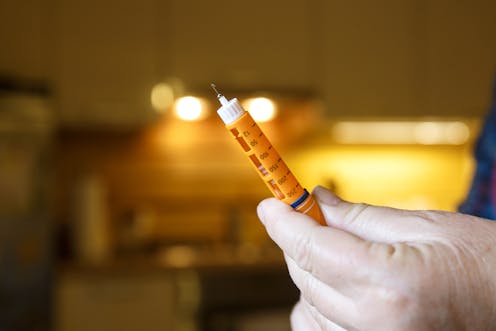Weekly injection could treat type 2 diabetes, new enzyme discovery suggests
- Written by Magdalene Montgomery, NHMRC CDF Fellow, Senior Research Fellow, Head Metabolic Crosstalk Laboratory, University of Melbourne

A newly discovered protein produced by the liver, and which helps to control blood sugar levels, could potentially revolutionise treatment for type 2 diabetes.
Our research, published today in Science Translational Medicine, found that injecting this protein, called SMOC1, into diabetic mice helped them control their blood glucose much more easily.
We have also engineered a long-lasting form of SMOC1 which, if it works the same way in humans as in mice, would only need to be injected once a week, rather than given daily as is the case for many current diabetes medications.
Our results in mice suggest SMOC1 is more effective than metformin, the current frontline drug for type 2 diabetes, in improving blood glucose control and insulin sensitivity. It’s also without the risk of dangerously low blood sugar associated with current drugs.
Most of us have friends, family members or colleagues with type 2 diabetes. This is not surprising, given the disease affects more than 400 million people worldwide, and almost one million in Australia alone.
Type 2 diabetes is also closely linked to obesity, and with the reported incidence of obesity growing (more than two billion people worldwide are overweight or obese), it is forecast 578 million adults will have diabetes by 2030, and 700 million by 2045.
People with diabetes have many complications that can impair their quality of life and reduce their life expectancy. A major problem for people with type 2 diabetes is high blood glucose, which if left unchecked and untreated, can cause the development of many serious health problems:
Almost every second person with diabetes experiences a mental illness, such depression or anxiety.
Reducing blood glucose levels before any sign of diabetes damage is evident can help thwart this silent and underestimated killer.
Current diabetes medications aren’t good enough
A healthy diet and exercise are the first lines of treatment for diabetes. But this has limited effectiveness in reducing blood glucose, particularly as the disease progresses. So it ultimately becomes necessary to use drugs to control blood glucose.
There are a range of drugs available to maintain blood glucose levels. The most common first-choice drug is metformin, which is prescribed to more than 120 million people worldwide. While metformin is generally safe and effective, it frequently causes gastrointestinal symptoms such as diarrhoea and flatulence.
 Metformin has long been doctors’ go-to drug for type 2 diabetes. Ash/Wikimedia Commons
Metformin has long been doctors’ go-to drug for type 2 diabetes. Ash/Wikimedia Commons
All diabetes medications, without exception, have either limited effectiveness or unpleasant side effects. Many can also potentially cause very low blood sugar (hypoglycemia), which can cause shakiness, anxiety, sweating, chills, lightheadedness, confusion and, in severe cases, coma or even death.
Insulin is used to treat type 2 diabetes typically later in disease progression, after other anti-hyperglycemic medications become less effective at managing blood glucose levels.
So, we can see there is an urgent need to develop new approaches to treat patients with this disease.
The next generation of diabetes therapies
Our discovery of SMOC1, which is naturally produced by the liver and is released into the blood when glucose levels are high, could offer a new way to control blood glucose.
We initially discovered SMOC1 as a protein that was released from mouse liver cells (hepatocytes). Its release increased when liver cells accumulated excess fat.
We further found SMOC1 levels in the blood to be reduced in people that are insulin resistant (pre-diabetic). Based on our animal studies and studies using human liver cells, we anticipate SMOC1 could be effective in people with type 2 diabetes, whether advanced or newly diagnosed. SMOC1 could make daily medications a thing of the past, boosting a patient’s quality of life.
Given the prevalence of type 2 diabetes, this would help reduce the public health burden of the disease, with patients potentially needing fewer hospital visits and shorter hospital stays.
Read more: Weekly Dose: metformin, the diabetes drug developed from French lilac
What happens next? We will need to test SMOC1 in humans, and enlist the help of the pharmaceutical industry to help develop this potential new therapy.
With the right support, SMOC1 could move to human trials within six to eight years, helping us get closer to reducing the global public health toll of type 2 diabetes and obesity in general.
Authors: Magdalene Montgomery, NHMRC CDF Fellow, Senior Research Fellow, Head Metabolic Crosstalk Laboratory, University of Melbourne



